 “There are two basic rules for running a literary quarterly: a) it should come out four times a year; b) after five or ten or fifteen years, with the passing of its generation, it should die. The Paris Review has failed to observe either of these rules. . . ” Read the rest Editor’s Note by Lorin Stein here.
“There are two basic rules for running a literary quarterly: a) it should come out four times a year; b) after five or ten or fifteen years, with the passing of its generation, it should die. The Paris Review has failed to observe either of these rules. . . ” Read the rest Editor’s Note by Lorin Stein here.
NewPages Magazine Stand – March 2012
Got a bookstore or library near you with dozens of new lit and alt mags on the racks? Yeah, me neither, which is why we created the NewPages Magazine Stand for information about some of the newest issues of literary and alternative magazines. The Magazine Stand entries are not reviews, but are descriptions provided by the sponsor magazine. Sometimes, we’ll have the newest issue and content on our site before the magazine even has it on theirs!
Still Point Arts Gallery Exhibit Online
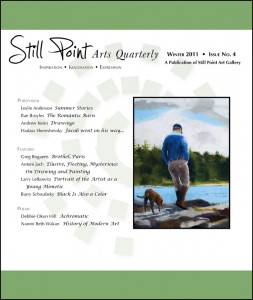 Still Point Art Gallery Current Exhibition THE ABSTRACTION ATTRACTION! opened on November 16 and will remain a featured exhibition through February 14. Abstract painting, photography, prints, and sculpture. Artists of Distinction for this show are Steven Bogart, Ling Ling Cheng, Nomi Drory, David Kinsey, Keith Parks, and Cat van der Heiden. These artists have also been awarded the opportunity to have their portfolios published in Still Point Arts Quarterly. The exhibit can be viewed in full on the Still Point Art Gallery website.
Still Point Art Gallery Current Exhibition THE ABSTRACTION ATTRACTION! opened on November 16 and will remain a featured exhibition through February 14. Abstract painting, photography, prints, and sculpture. Artists of Distinction for this show are Steven Bogart, Ling Ling Cheng, Nomi Drory, David Kinsey, Keith Parks, and Cat van der Heiden. These artists have also been awarded the opportunity to have their portfolios published in Still Point Arts Quarterly. The exhibit can be viewed in full on the Still Point Art Gallery website.
Prairie Schooner Contemporary Irish Writing Issue
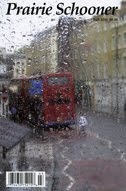 Prairie Schooner Winter 2011 is a special issue devoted to contemporary Irish writing. As Interim Senior Editor Stephen C. Behrendt writes: “Unlike many ‘special issues’ of journals, this one has not begun with a predetermined narrow list of contributors from whom we solicited the contributions that now appear here. Instead, we have happily welcomed the work of many writers who responded to our general invitation for submissions, and this present issue samples some of the most compelling and vibrant contributions from among this wealth of splendid material. It represents, then, a cross section of the Irish writing community today, in all its rich diversity. . . The poetry , fiction, and drama in this issue testify to the enduring themes not just of Irish culturebut indeed of the whole human enterprise.”
Prairie Schooner Winter 2011 is a special issue devoted to contemporary Irish writing. As Interim Senior Editor Stephen C. Behrendt writes: “Unlike many ‘special issues’ of journals, this one has not begun with a predetermined narrow list of contributors from whom we solicited the contributions that now appear here. Instead, we have happily welcomed the work of many writers who responded to our general invitation for submissions, and this present issue samples some of the most compelling and vibrant contributions from among this wealth of splendid material. It represents, then, a cross section of the Irish writing community today, in all its rich diversity. . . The poetry , fiction, and drama in this issue testify to the enduring themes not just of Irish culturebut indeed of the whole human enterprise.”
Iron Horse Review Single Author Issue
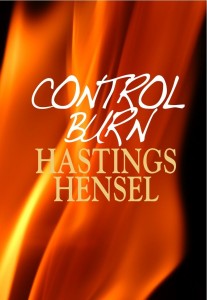 It would be impossible to know from the cover that Control Burn, a collection of poems by Hastings Hensel, is the latest issue of the Iron Horse Literary Review. A few years ago, IHR changed its publication cycle to six “slim” volumes a year. While other publications were ‘downsizing’ to less print/more online, IHR shifted to less print/more often. There’s no doubt the idea of ‘slim volumes’ of fiction, poetry, nonfiction and photography fits neatly into our busy lives, and IHR added yet another unique feature to their line-up: an entire volume dedicated to one author. Every year, IHR publishes a chapbook of poetry, fiction, or essays. These issues look like a regular, single-author book, and “help to promote the work of writers in the early stages of their careers.”
It would be impossible to know from the cover that Control Burn, a collection of poems by Hastings Hensel, is the latest issue of the Iron Horse Literary Review. A few years ago, IHR changed its publication cycle to six “slim” volumes a year. While other publications were ‘downsizing’ to less print/more online, IHR shifted to less print/more often. There’s no doubt the idea of ‘slim volumes’ of fiction, poetry, nonfiction and photography fits neatly into our busy lives, and IHR added yet another unique feature to their line-up: an entire volume dedicated to one author. Every year, IHR publishes a chapbook of poetry, fiction, or essays. These issues look like a regular, single-author book, and “help to promote the work of writers in the early stages of their careers.”
RATTLE Tribute to Buddhist Poets
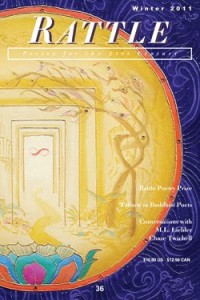 RATTLE Winter 2011 highlights the work of 30 contemporary Buddhist poets. As Dick Allen writes in his introduction, Buddhism “is not a glimpse or gaze but an immersion. There’s no glass, no other side.” Informed by years of studying human experience from their unique perspectives, these poets have much to offer Buddhists and non-Buddhists alike. Additionally, in the conversations section, Alan Fox speaks with M.L. Liebler and Buddhist poet Chase Twichell.
RATTLE Winter 2011 highlights the work of 30 contemporary Buddhist poets. As Dick Allen writes in his introduction, Buddhism “is not a glimpse or gaze but an immersion. There’s no glass, no other side.” Informed by years of studying human experience from their unique perspectives, these poets have much to offer Buddhists and non-Buddhists alike. Additionally, in the conversations section, Alan Fox speaks with M.L. Liebler and Buddhist poet Chase Twichell.
Authors featured in the tribute include Dick Allen, Li Bai, Pam Herbert Barger, Karen Benke, John Brehm, Toni Cameron, Louisa Diodato, Teresa Chuc Dowell, Jeffrey Franklin, Robert Funge, Gary Gach, Dan Gerber, Sam Hamill, Gail Hanlon, Lola Haskins, Donna Henderson, Yang Jian, Bo Juyi, Alison Luterman, Paul Pedroza, Peg Quinn, Diana M. Raab, Richard Schiffman, Jinen Jason Shulman, Sarah Pemberton Strong, Anne Swannell, Robert Tremmel, Tony Trigilio, Chase Twichell, and Jack Vian.
[Cover art by Toni Cameron.]
Arkansas Review: 50th Anniversary of the Civil Rights Movement
The Summer/August 2011 issue of Arkansas Review: A Journal of Delta Studies, commemorates Civil Rights Activism in Arkansas. Induced in the issue are the articles: “Battle Cry of Freedom: Little Rock, Arkansas, and the Freedom Rides at Fifty” by John A. Kirk, “‘We Became Radicalized by What We Experienced’: Excerpts from an Interview with William (Bill) Hansen, Director of the Student Nonviolent Coordinating Committee’s Arkansas Project, July 22, 1997” by Jennifer Jensen Wallach, and “Why the 50th Anniversary of the Civil Rights Movement is More Important than the 150th Anniversary of the Civil War” a panel discussion with John A. Kirk, Grif Stockley, and Spirit Trickey.
Matchbook
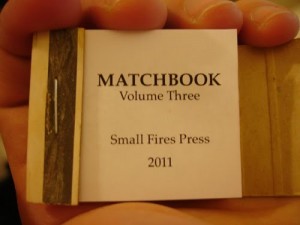 Don’t let the size (nor former function) fool you – these matchbooks pack a lotta lit into them. Published by Small Fire Press, this third volume includes poets Anna Moschovakis, Jen Hofer, Tony Mancus, MC Hyland, Kate Lebo, Vince Gotera, Daniela Olszewska, Sophie Klahr, Brooklyn Copeland, Anne Marie Rooney, Ben Pelham, Trey Moody, Justin Runge, Marshall Walker Lee, Lisa Ciccarello, W. Vandoren Wheeler, Greg Weiss, Jasmine Dreame Wagner, Chris Hosea, Fred Schmalz, & Stacy Blint with letter-pressed illustrations by Cherie Weaver. Yes, all in a matchbook cover.
Don’t let the size (nor former function) fool you – these matchbooks pack a lotta lit into them. Published by Small Fire Press, this third volume includes poets Anna Moschovakis, Jen Hofer, Tony Mancus, MC Hyland, Kate Lebo, Vince Gotera, Daniela Olszewska, Sophie Klahr, Brooklyn Copeland, Anne Marie Rooney, Ben Pelham, Trey Moody, Justin Runge, Marshall Walker Lee, Lisa Ciccarello, W. Vandoren Wheeler, Greg Weiss, Jasmine Dreame Wagner, Chris Hosea, Fred Schmalz, & Stacy Blint with letter-pressed illustrations by Cherie Weaver. Yes, all in a matchbook cover.
Due to the vintage upcycling, each cover is different. I got: Loyal Order of Moose, Lodge No. 1151 (“For Fun and Fellowship”), Greensburg, PA, and the other: Larry’s Utoco Service, Twin, Idaho. Considering the number of no-smoking cities cropping up, it’s a treat to see these covers given new life and purpose.
As for reading, the font is maybe a 10-point, not difficult at all (even for my elder eyes) thanks to quality printing – which includes color. The stapled edge makes some of the margins a bit close, needing a precarious pull to read final lines, but the construction held firm to every tug. And again, don’t let the size fool you. The density of the writing is not one I would recommended reading all in one sitting, though it could be done. These are great ‘volumes’ to carry along in a purse, bag, or pocket, and pull out on those bus rides or while in queues (though not a recommended pun for smokers looking for a light).
The only unfortunate issue I had with one Matchbook I received was that some pages were out of order. I found following one of the poems difficult when it dawned on me that this might be the issue. I looked through the second copy of the matchbook I’d received and realized this had been the error. Well, oops. While it detracted momentarily from my reading, I had a certain level of empathy in considering these are most likely DIY hand-pieced together. Still, in fairness, I need to mention it. I’m sure as a subscriber, I could have contacted Small Fire Press for a replacement.
For lovers of literature and the simple oddities of life, Matchbook is truly a publication small and cute enough to coddle, but big enough to feed your soul. Pack it along, I say.
Confrontations Takes on Art
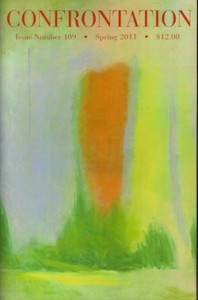 According to editor Jonna G. Semeiks, for the first time in its over 40-year publishing history, Confrontations has included a section devoted to visual art. The artist (whose work is also featured on the cover) is Esteban Vicente, “an immigrant who left Spain during the Civil War in the 1930’s and settled on the Lower East Side of Manhattan.” Along with the editorial introduction, there is an bio before the images, and eight four, two-sided, full-color, full-bleed pages of his paintings featured. For its inaugural foray into art inclusion, Confrontations has shown great sensibility it how to do it right.
According to editor Jonna G. Semeiks, for the first time in its over 40-year publishing history, Confrontations has included a section devoted to visual art. The artist (whose work is also featured on the cover) is Esteban Vicente, “an immigrant who left Spain during the Civil War in the 1930’s and settled on the Lower East Side of Manhattan.” Along with the editorial introduction, there is an bio before the images, and eight four, two-sided, full-color, full-bleed pages of his paintings featured. For its inaugural foray into art inclusion, Confrontations has shown great sensibility it how to do it right.
Stunning Covers: Calyx
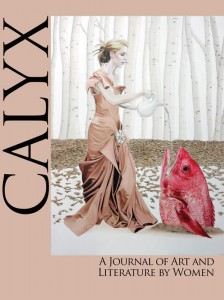 Celebrating 35 years of continuous publishing, Calyx: A Journal of Art and Literature by Women Summer 2011 features the cover art “Adaptation” (acrylic on canvas, 36″ x 48″) by Amy Guidry. It can be viewed in a larger image in the Calyx website. More of Guidry’s work is featured inside the magazine, along with that of Christine Wuenschel, Marie Le Glatin Keis, Alethea Norene, RoByn Thompson, Kathline Carr and Lu – all in full color on glossy center pages.
Celebrating 35 years of continuous publishing, Calyx: A Journal of Art and Literature by Women Summer 2011 features the cover art “Adaptation” (acrylic on canvas, 36″ x 48″) by Amy Guidry. It can be viewed in a larger image in the Calyx website. More of Guidry’s work is featured inside the magazine, along with that of Christine Wuenschel, Marie Le Glatin Keis, Alethea Norene, RoByn Thompson, Kathline Carr and Lu – all in full color on glossy center pages.
Anniversary: Ploughshares 40th
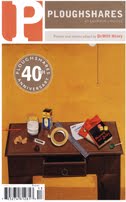 To celebrate its 40th year of publication, the Fall 2011 issue of Ploughshares brings back former guest editors “to contribute new works of their own, to nominate and introduce an emerging writer, or to give an account of turning points in their careers.” A full list of the contents is available on the website, though it does not indicate which new writers are being introduced by guest editors. Ploughshares changes active content links each day for the current issue.
To celebrate its 40th year of publication, the Fall 2011 issue of Ploughshares brings back former guest editors “to contribute new works of their own, to nominate and introduce an emerging writer, or to give an account of turning points in their careers.” A full list of the contents is available on the website, though it does not indicate which new writers are being introduced by guest editors. Ploughshares changes active content links each day for the current issue.
Georgia Review Features Stephen Dunn
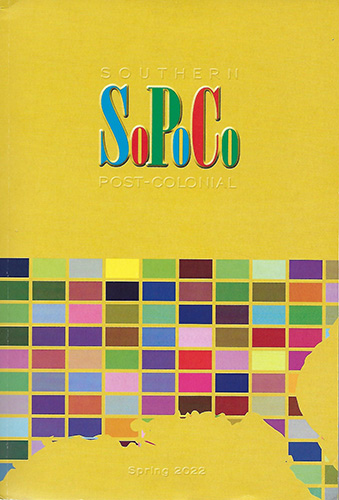 The Summer 2011 issue of The Georgia Review includes a special feature on Pulitzer Prize-winning poet Stephen Dunn: “Many a Beautiful Strangeness.” The feature is well deserved, as TGR Editor Stephen Corey notes: “…since 1980 The Georgia Review has, up through this issue, presented more than fifty of Stephen Dunn’s poems and five of his essays—plus an interview conducted by Laura McCullough [available in full on the TGR website] and a self-conducted ‘intraview,’ both of which appear here in Summer 2011. All told, Stephen Dunn’s Georgia Review poetry offerings would fill a book of nearly one hundred pages — W. W. Norton, are you listening? — and the full body of his contributions would just about flesh out an entire issue of our journal.” Read the full editorial online here, as well as the full table of contents here.
The Summer 2011 issue of The Georgia Review includes a special feature on Pulitzer Prize-winning poet Stephen Dunn: “Many a Beautiful Strangeness.” The feature is well deserved, as TGR Editor Stephen Corey notes: “…since 1980 The Georgia Review has, up through this issue, presented more than fifty of Stephen Dunn’s poems and five of his essays—plus an interview conducted by Laura McCullough [available in full on the TGR website] and a self-conducted ‘intraview,’ both of which appear here in Summer 2011. All told, Stephen Dunn’s Georgia Review poetry offerings would fill a book of nearly one hundred pages — W. W. Norton, are you listening? — and the full body of his contributions would just about flesh out an entire issue of our journal.” Read the full editorial online here, as well as the full table of contents here.
BPJ Devotes Issue & Forum to “The Logic of Yoo”
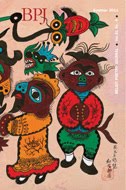 The Fall 2011 issue of Beloit Poetry Journal is devoted to chapbook of poems which come from a larger manuscript of the same name, Michael Broek’s “The Logic of Yoo.” The poem “probes the moral logic of George W. Bush’s legal counsel John C. Yoo from the perspective of a graduate student who supplements his income by writing academic papers for hire. Ten years into the ‘war on terror,’ the issues the poem raises remain acutely relevant.” (BPJ) The BPJ website includes a PDF of the first dozen pages of the poem. The BPJ website will also feature Michael Brock moderating a discussion of The Logic of Yoo for the September Poet’s Forum. (Great opportunity for teachers and their students!)
The Fall 2011 issue of Beloit Poetry Journal is devoted to chapbook of poems which come from a larger manuscript of the same name, Michael Broek’s “The Logic of Yoo.” The poem “probes the moral logic of George W. Bush’s legal counsel John C. Yoo from the perspective of a graduate student who supplements his income by writing academic papers for hire. Ten years into the ‘war on terror,’ the issues the poem raises remain acutely relevant.” (BPJ) The BPJ website includes a PDF of the first dozen pages of the poem. The BPJ website will also feature Michael Brock moderating a discussion of The Logic of Yoo for the September Poet’s Forum. (Great opportunity for teachers and their students!)
[Cover Image: Photograph by Linda Connor]
WLT: Poetry Untethered
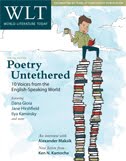 The newest issue of World Literature Today (celebrating 85 years of continous publication) includes the special section “Poetry Untethered: 10 Voices from the English-Speaking World.” In addition to their regular content, this section includes contributions from John Mateer, Dana Gioia, Stephanie McKenzie, Nicholas Samaras, Bill Manhire (“Cream Torpedoes: Recent Poetry in New Zealand”), Maya Khosla, Ilya Kaminsky, Jane Hirshfield (“What is American in Modern American Poetry: A Primer with Poems”), Ngwatilo Mawiyoo, and Ian Brinton (“Pods, Presses, and Pamphlets: Poetry in England Today”). Also included is an extensive interview by Michelle Johnson with Dana Gioia.
The newest issue of World Literature Today (celebrating 85 years of continous publication) includes the special section “Poetry Untethered: 10 Voices from the English-Speaking World.” In addition to their regular content, this section includes contributions from John Mateer, Dana Gioia, Stephanie McKenzie, Nicholas Samaras, Bill Manhire (“Cream Torpedoes: Recent Poetry in New Zealand”), Maya Khosla, Ilya Kaminsky, Jane Hirshfield (“What is American in Modern American Poetry: A Primer with Poems”), Ngwatilo Mawiyoo, and Ian Brinton (“Pods, Presses, and Pamphlets: Poetry in England Today”). Also included is an extensive interview by Michelle Johnson with Dana Gioia.
A full table of contents is available online with access to some of the above listed features. WLT also offers exclusive web content available for all visitors.
Tampa Review: Art Blast from the Past
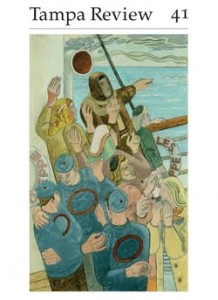 Tampa Review 41 offers a unique volume by pairing contemporary stories and poems with antique art from the fifteenth century and the early twentieth century, as well as a special sampling of art from the Vorticist movement, a “lively alliance of literary and visual artists before World War I that included Ezra Pound, T. S. Eliot, Wyndham Lewis, and a famous literary magazine called Blast.”
Tampa Review 41 offers a unique volume by pairing contemporary stories and poems with antique art from the fifteenth century and the early twentieth century, as well as a special sampling of art from the Vorticist movement, a “lively alliance of literary and visual artists before World War I that included Ezra Pound, T. S. Eliot, Wyndham Lewis, and a famous literary magazine called Blast.”
Manoa: Voices of the Okinawan Spirit
 The newest issue of Manoa is Living Spirit: Literature and Resurgence in Okinawa. The publication is a collection of works from the Ryūkyūs, “Most of which have never been translated into English, or are newly translated for this volume. This issue is a “sister” volume to Manoa 2009, Voices from Okinawa – a collection of plays and essays by Okinawan Americans. In addition to the written works, this Living Spirit issue includes a series of photographs by Higa Yasuo, whose subjects include three decades of his study and recording of ancient and sacred religious festivals of Okinawa. Visit the Manoa Voices of the Okinawan Spirit blog for more information.
The newest issue of Manoa is Living Spirit: Literature and Resurgence in Okinawa. The publication is a collection of works from the Ryūkyūs, “Most of which have never been translated into English, or are newly translated for this volume. This issue is a “sister” volume to Manoa 2009, Voices from Okinawa – a collection of plays and essays by Okinawan Americans. In addition to the written works, this Living Spirit issue includes a series of photographs by Higa Yasuo, whose subjects include three decades of his study and recording of ancient and sacred religious festivals of Okinawa. Visit the Manoa Voices of the Okinawan Spirit blog for more information.
Fact-Simile Trading Cards
 In addition to their twice annual, large-format (8.5×11) literary journal, Fact-Simile has brought back their of Poetry Trading Cards. Printed on traditional trading card stock with a plastic sleeve, there are several ways to get them in your hands – 99 cents each or $10 for the year (+s/h). You can still subscribe now and get the “back issues” as well as receive monthly delivery for the remainder of the year. Cards from the 2010 series are also still available.
In addition to their twice annual, large-format (8.5×11) literary journal, Fact-Simile has brought back their of Poetry Trading Cards. Printed on traditional trading card stock with a plastic sleeve, there are several ways to get them in your hands – 99 cents each or $10 for the year (+s/h). You can still subscribe now and get the “back issues” as well as receive monthly delivery for the remainder of the year. Cards from the 2010 series are also still available.
The 2011 Poetry Trading Cards thus far:
January/Nathaniel Tarn
February/Charles Bernstein
March/Rachel Blau DuPlessis
April/Joanne Kyger
May/CA Conrad
June/Amiri Baraka
July/Charles Alexander
Kaleidoscope Animals Issue
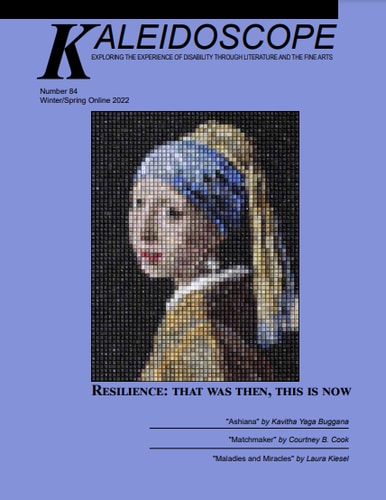 Issue Number 63 of Kaleidoscope: Exploring the experience of disability through literature and the fine arts, is themed “Animals That Make a Difference.” This is a great issue for animal lovers, from the editorial by Gail Willmott on her life-long love affair with cats, to Deshae E. Lott’s feature essay, “It’s Not About the Dog,” the issue is jam-packed with essays, poetry, fiction, and creative nonfiction all centered around animals: dogs, cats, rabbits, birds – with a particular focus on the human-animal bond in relation to issues of disability.
Issue Number 63 of Kaleidoscope: Exploring the experience of disability through literature and the fine arts, is themed “Animals That Make a Difference.” This is a great issue for animal lovers, from the editorial by Gail Willmott on her life-long love affair with cats, to Deshae E. Lott’s feature essay, “It’s Not About the Dog,” the issue is jam-packed with essays, poetry, fiction, and creative nonfiction all centered around animals: dogs, cats, rabbits, birds – with a particular focus on the human-animal bond in relation to issues of disability.
Annalemma’s “Creation” Issue
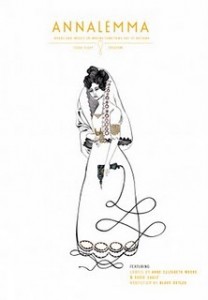 Issue Eight of Annalemma is themed “Creation” and came about, Editor Chris Heavener writes in the intro, when a friend of his suggested he “do an issue of Annalemma all about making things. It would be nonfiction focused. Maybe it would have a few fiction pieces thrown in there for fun, but the contents would consist mainly of profiles and interviews with woodworkers, chefs, designers, manufacturers, and artisans of all stripes. It would be a celebration of craft, of people who devote their lives to a trade and do what they do with grace, precision, and beauty.”
Issue Eight of Annalemma is themed “Creation” and came about, Editor Chris Heavener writes in the intro, when a friend of his suggested he “do an issue of Annalemma all about making things. It would be nonfiction focused. Maybe it would have a few fiction pieces thrown in there for fun, but the contents would consist mainly of profiles and interviews with woodworkers, chefs, designers, manufacturers, and artisans of all stripes. It would be a celebration of craft, of people who devote their lives to a trade and do what they do with grace, precision, and beauty.”
The resulting issue includes Barry Grass talking with Belgium artesian brewer Dany Prignon of the Fantôme Brewery, designer/dressmaker Jen O’Malley on the American history of the bridal gown, and author/activist Anne Elizabeth Moore on gender inequality in the world of comic books – among many other “creation” themed works. The issue is also features a generous amount of full-color artwork and photography throughout.
[Cover art by Amber Albrecht.]
Stunning Covers :: Palooka
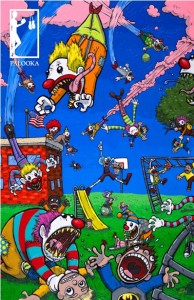 Palooka: Issue 2 – cover art, “Flying Clowns Descend on the Schoolyard” by Joe Harvasy (2008). I have a friend who is deathly afraid of clowns who would find this cover stunning in a very literal-psychological sense. I find the colors (great reproduction) and style to be the stunner; the clowns themselves – well, there’s some dark humor at work here I can appreciate. Havasy comments on the artwork: “The flying clowns painting was originally a print I did for a show titled ‘They’re Out to Get Me’ about childhood fears. I wanted to show clowns doing everything scary possible. Four years later the Alcove Gallery was having a show titled ‘Circus,’ and I decided to do a gigantic 2′ x 3′ painting of the clowns. The painting currently resides in Oslo, Norway, in the collection of Nicholas Paulik.”
Palooka: Issue 2 – cover art, “Flying Clowns Descend on the Schoolyard” by Joe Harvasy (2008). I have a friend who is deathly afraid of clowns who would find this cover stunning in a very literal-psychological sense. I find the colors (great reproduction) and style to be the stunner; the clowns themselves – well, there’s some dark humor at work here I can appreciate. Havasy comments on the artwork: “The flying clowns painting was originally a print I did for a show titled ‘They’re Out to Get Me’ about childhood fears. I wanted to show clowns doing everything scary possible. Four years later the Alcove Gallery was having a show titled ‘Circus,’ and I decided to do a gigantic 2′ x 3′ painting of the clowns. The painting currently resides in Oslo, Norway, in the collection of Nicholas Paulik.”
The Long Poem / Series Issue
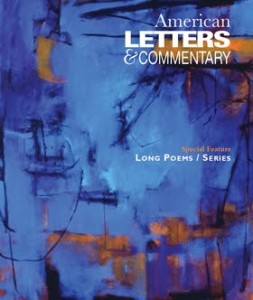 The newest American Letters & Commentary (Issue #22) includes a special feature dedicated to “the long poem/series.” In the introduction to the feature, Editors Catherine Kasper and David Ray Vance write: “In western literary culture, ‘The Long Poem’ is as ancient as the epic…For literary magazine editors, however, long poems or series can be problematic. Works that are interlinked and lengthy often run up against the financial realities of small press production. Even where money isn’t an issue and editors have plenty of pages to work with, they’re often reluctant to devote too much space to a single author. And so, long poems and series are largely eschewed in favor of work that can fit in the space of a page.” They go on to discuss Lynn Keller’s perspective about the perseverance and reinvention of the long poem as it continues today, and their decision to dedicate space to “longer” works in this issue.
The newest American Letters & Commentary (Issue #22) includes a special feature dedicated to “the long poem/series.” In the introduction to the feature, Editors Catherine Kasper and David Ray Vance write: “In western literary culture, ‘The Long Poem’ is as ancient as the epic…For literary magazine editors, however, long poems or series can be problematic. Works that are interlinked and lengthy often run up against the financial realities of small press production. Even where money isn’t an issue and editors have plenty of pages to work with, they’re often reluctant to devote too much space to a single author. And so, long poems and series are largely eschewed in favor of work that can fit in the space of a page.” They go on to discuss Lynn Keller’s perspective about the perseverance and reinvention of the long poem as it continues today, and their decision to dedicate space to “longer” works in this issue.
The special feature includes a series of oil paintings (full color) by Caryn Friedlander, and long poems or poems in a series by Cecily Parks, Laura Goldsteins, Dan Kaplan, Megan Kaminski, Darin Ciccotelli, Jenny Gropp Hess, Sarah Mangold, James Meetze, Ailish Hopper, Pattabi Seshadri, Terence Huber, Jakob Stein, Nathan Hauke, Alexandra Mattraw, Joyelle Mcsweeney, Rebecca Givens Rolland, and Steve Barbaro.
[Cover art by Caryn Friedlander.]
Daniel Nester on Origin Stories
“Every child relies on someone else to make ground for their origin story, where their body comes from. My first memory takes place in my grandparents’ backyard, where my mother is showing me a broken milk bottle. She tells me that I ‘have to use big people glasses now.’ No more bottles. It’s one of those maternal dupes, a necessary deception to move things along. My mother denies this ever happened. I remember it vividly, down to the poison ivy under the bush, brushing against my legs.”
Daniel Nester, from “The Writer is Present,” published in the independent online lit mag Painted Bride Quarterly #84
Pre-order Anobium
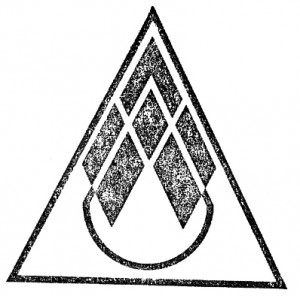 Anobium: Volume 1 (Summer 2011) is available for pre-order price of $9.99 – which includes shipping and other “random goodies” – until July 31. After that, the price is $12. Anobium will be 84pp. of new writing from Laura Carter, Jennifer L. Collins, William Doreski, Eric Evans, Ricky Garni, Jonathan Greenhause, Luke Irwin, Rich Ives, Eddie Jones, J.S. MacLean, Claire McCurdy, Bethany Minton, Thomas Mundt, Ben Nardolilli, James Payne, Stephanie Plenner, Graham Tugwell, Meredith Turits, and Susan Yount. It also features a new story and a never-before-seen interview with Chicago’s Joe Meno. The volume also features new art from Anobium’s resident illustrator, Jacob van Loon.
Anobium: Volume 1 (Summer 2011) is available for pre-order price of $9.99 – which includes shipping and other “random goodies” – until July 31. After that, the price is $12. Anobium will be 84pp. of new writing from Laura Carter, Jennifer L. Collins, William Doreski, Eric Evans, Ricky Garni, Jonathan Greenhause, Luke Irwin, Rich Ives, Eddie Jones, J.S. MacLean, Claire McCurdy, Bethany Minton, Thomas Mundt, Ben Nardolilli, James Payne, Stephanie Plenner, Graham Tugwell, Meredith Turits, and Susan Yount. It also features a new story and a never-before-seen interview with Chicago’s Joe Meno. The volume also features new art from Anobium’s resident illustrator, Jacob van Loon.
WLT Features Italian LIterature
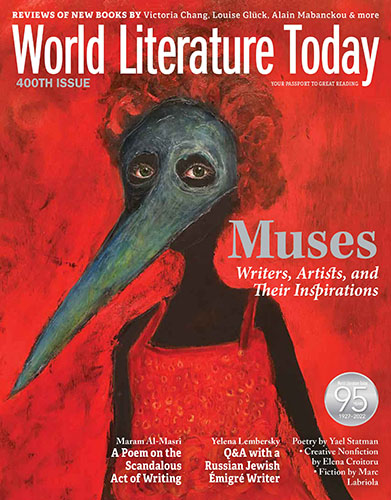 Celebrating 85 years of continuous publication, World Literature Today proves once again why it is an invaluable publication with “Voices of Italian Literature” in the July/August 2011 issue. This special sections features an interview with Dacia Maraini*, essays by Antony Shugaar and Jamie Richards, poetry by Andrea Zanzotto, Fernanda Romagnoli, Luciano Erba, Tiziano Scarpa, Maria Luisa Spaziani*, Pier Luigi Bacchini*, Patrizia Cavalli*, Gianni Celati, Antonella Anedda, Valerio Magrelli, and Alessio Zanelli, and fiction by Amara Lakhous and Ermanno Cavazzoni. (Asterisk indicates content also available online.)
Celebrating 85 years of continuous publication, World Literature Today proves once again why it is an invaluable publication with “Voices of Italian Literature” in the July/August 2011 issue. This special sections features an interview with Dacia Maraini*, essays by Antony Shugaar and Jamie Richards, poetry by Andrea Zanzotto, Fernanda Romagnoli, Luciano Erba, Tiziano Scarpa, Maria Luisa Spaziani*, Pier Luigi Bacchini*, Patrizia Cavalli*, Gianni Celati, Antonella Anedda, Valerio Magrelli, and Alessio Zanelli, and fiction by Amara Lakhous and Ermanno Cavazzoni. (Asterisk indicates content also available online.)
WLT also offers exclusive web content: poetry by Ascanio Celestini, Leonardo Sinisgalli and Julian Stannard, and fiction by Ermanno Cavazzoni.
Think Symposium on Forum
 The most recent issue of Think Journal (3.4) is dedicated to the Symposium: What We Talk About When We Talk About Form. “This is a round-table discussion conducted between March and May, 2011, among Ernest Hilbert, Julie Kane, Kate Northrop, David J. Rothman (co-moderator), David Sanders, Timothy Steele, Marilyn Taylor, Deborah Warren, James Matthew Wilson, with Christine Yurick as the moderator. Simon Jarvis and Tom Cable were asked to comment on the discussion in its entirety and their responses are included as an epilogue.”
The most recent issue of Think Journal (3.4) is dedicated to the Symposium: What We Talk About When We Talk About Form. “This is a round-table discussion conducted between March and May, 2011, among Ernest Hilbert, Julie Kane, Kate Northrop, David J. Rothman (co-moderator), David Sanders, Timothy Steele, Marilyn Taylor, Deborah Warren, James Matthew Wilson, with Christine Yurick as the moderator. Simon Jarvis and Tom Cable were asked to comment on the discussion in its entirety and their responses are included as an epilogue.”
Cooking in Rome with Alimentum
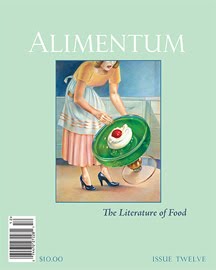 Cook & Tour in Rome, Italy w/ Alimentum Publisher Paulette Licitra
Cook & Tour in Rome, Italy w/ Alimentum Publisher Paulette Licitra
October 11-17, 2011
Shop at the outdoor food markets, small food shops, Roman supermarkets and bring the bounty back to a fabulous apartment in the historic center of Rome to cook and dine.
Tour Rome’s best of best places: Piazza Navona, Trevi Fountain, Pantheon, Spanish Steps, Capitoline Hill, Coliseum, St. Peter’s, Teatro Marcellus, Bocca di Verita, and more, plus great neighborhoods for shopping: boutiques, flea markets, and department stores.
Event: Notes on Writing Issue
 Issue 40.1 of Event: Poetry and Prose includes a special section titled “Notes on Writing” and features works by Lynn Crosbie, Amber Dawn, Charles Demer, Jenn Farrell, Ray Hsu, Debra Marquart, and Susan Olding.
Issue 40.1 of Event: Poetry and Prose includes a special section titled “Notes on Writing” and features works by Lynn Crosbie, Amber Dawn, Charles Demer, Jenn Farrell, Ray Hsu, Debra Marquart, and Susan Olding.
Chicago Review: New Italian Writing
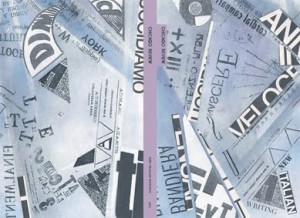 Chicago Review 56.1 is an issue devoted to New Italian Writing: Poetry, fiction, and criticism translated into English for the first time. Translators include: V. Joshua Adams, Anne Milano Appel, Sarah Arvio, Robert P. Baird, Lisa Barca, Patrick Barron, Jacob Blakesley, Joel Calahan, Maggie Fritz-Morkin, Elizabeth Harris, Chris Glomski, Peter Hainsworth, Laura Modigliani, Dylan J. Montanari, Gianluca Rizzo, Jennifer Scappettone, Dominic Siracusa, Kate Soto, and Paul Vangelisti.
Chicago Review 56.1 is an issue devoted to New Italian Writing: Poetry, fiction, and criticism translated into English for the first time. Translators include: V. Joshua Adams, Anne Milano Appel, Sarah Arvio, Robert P. Baird, Lisa Barca, Patrick Barron, Jacob Blakesley, Joel Calahan, Maggie Fritz-Morkin, Elizabeth Harris, Chris Glomski, Peter Hainsworth, Laura Modigliani, Dylan J. Montanari, Gianluca Rizzo, Jennifer Scappettone, Dominic Siracusa, Kate Soto, and Paul Vangelisti.
The issue also includes a comprehensive checklist of recent Italian anthologies and letters by Cole Swensen, Kent Johnson, John Gallaher, and Richard Owens in response to Keith Tuma’s essay “After the Bubble” (CR 55-3/4).
A complete list of contents is available on the here.
TLR Goes Emo
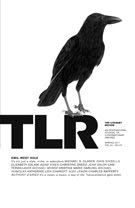 “Emo, Meet Hole” is the title of The Literary Review‘s Spring 2011 issue. Editor Minn Proctor writes, “Whether or not I associate emo (acute aesthetic sensitivity disorder coupled with a tendency to self dramatization) with poetry because Lord Byron is an oft-cited progenitor or because my ex-poet-boyfriend liked Morrissey too much, the spectre of a brooding young man with wet eyes and disheveled hair looks quaintly over a certain tenor of literature…and exes, too. Much to my poetry editor’s dismay, I called for an emo-themed issue of TLR. My undergraduate interns thought it was hilariously apropos and everyone else thought I was speaking in tongues. And yet we moved forth.”
“Emo, Meet Hole” is the title of The Literary Review‘s Spring 2011 issue. Editor Minn Proctor writes, “Whether or not I associate emo (acute aesthetic sensitivity disorder coupled with a tendency to self dramatization) with poetry because Lord Byron is an oft-cited progenitor or because my ex-poet-boyfriend liked Morrissey too much, the spectre of a brooding young man with wet eyes and disheveled hair looks quaintly over a certain tenor of literature…and exes, too. Much to my poetry editor’s dismay, I called for an emo-themed issue of TLR. My undergraduate interns thought it was hilariously apropos and everyone else thought I was speaking in tongues. And yet we moved forth.”
The result is the current issue, with poetry, fiction, and essays by over a dozen authors as well as a variety of book reviews. Several pieces are available full-text online: Poetry by Michael Morse, “Void and Compensation (Poem as Aporia Between Lighthouses),” and Michael Homolka, “Thirteenth Birthday”; Fiction by Christine Sneed, “Roger Weber Would Like To Stay”; and an essay by Anthony D’Aries, “The Language of Men.”
[Cover art by Carrie Marill.]
NDQ Looks at Hemingway Then & Now
Volume 76, Numbers 1 & 2 of North Dakota Quarterly is devoted to “Hemingway in His and Our Time” and features the following authors and their works:
H. R. Stoneback
For Whom the Flood Rolls: Ernest Hemingway and Robert Penn Warren—Connections and Echoes, Allusion, and Intertextuality
Ben Stoltzfus
Hemingway’s Iceberg: Camus’ L’Etranger and The Sun Also Rises
Jeffrey Herlihy
The Complications of Exile in Ernest Hemingway’s The Sun Also Rises
Joseph Holt
The Textual Condition of Hemingway’s African Book
Walter Houk
Hemingway’s Cuban Son Looks Back on Life with Papa
Allen Josephs
Confessions of an Animal Lover: Clearing Up a Few Things about Hemingway, Spain, and the Bulls
Allen Josephs
Picasso, Hemingway, and Lorca: or Toreo As a Modernist Principle
Melanie Conroy-Goldman
10,000 Words (story)
Matthew Nickel
Lighthearted Sinners and Pious Puritans, Followers, and Believers: Hemingway’s “Holy War Meat Eaters and Beer Drinkers Happy Hunting Ground and Mountain Religion” in Under Kilimanjaro
Brad McDuffie
Teaching In Our Time to Freshmen (poem)
Donald Junkins
Martha Gellhorn’s Letters
David Raabe
Dempsey over Hemingway in Three Rounds
Robert E. Fleming
The Deaths of the Children in Islands in the Stream
Robert E. Gajdusek
Bimini
Ron McFarland
Three Novels on Hemingway in Cuba
Zak Haselmo
Hemingway: Eight Decades of Criticism
Donald A. Daiker
“Don’t Get Drunk, Jake”: Drinking, Drunkenness, and Sobriety in The Sun Also Rises
Marina Gradoli
Hemingway’s Criteria in Ordering the Sequence of the Vignettes of in our time (1924) and In Our Time (1925)
Fugue Explores New Forms
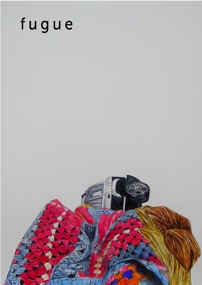 Fugue‘s newest issue (#40) has been dubbed the “Play” issue. The introductory note introduces that “Issue #40 of Fugue has been designed to show how writers are beautifully and smartly playing with genre, form, content and idea. Lyric essay, collage, prose poem, micro fiction, the panharmonicon and the experiment are not new terms, but the evolution of these terms, relevant to the evolution of our culture, has caused writers to create new forms of writing that are as inventive as they are accessible.”
Fugue‘s newest issue (#40) has been dubbed the “Play” issue. The introductory note introduces that “Issue #40 of Fugue has been designed to show how writers are beautifully and smartly playing with genre, form, content and idea. Lyric essay, collage, prose poem, micro fiction, the panharmonicon and the experiment are not new terms, but the evolution of these terms, relevant to the evolution of our culture, has caused writers to create new forms of writing that are as inventive as they are accessible.”
Authors include (* authors works available on Fugue’s website): Rebecca McClanahan & Dinty W. Moore, Michael Martone, Anne Panning, Alexandra Ghaly*, Kim Dana Kupperman, Kyle Dargan, Guy Jean, translated by Ilya Kaminsky and Kathryn Farris, Ander Monson, Marvin Bell, Valerie Miner, Brenda Miller, Jennifer Kanke, S.L. Wisenberg, Ely Shipley, Jennifer Campbell, Laurel Bastian, Rachel Yoder, Derek Juntunen*, Joe Wenderoth, E. Shaskan Bumas*, Rebecca McClanahan, Iris Moulton, and Lia Purpura.
Hayden’s Ferry on Short Forms
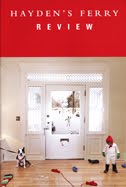 The Spring/Summer 2011 issue of Hayden’s Ferry Review includes a special section on Short Forms and includes works by Kevin McIlvoy, Darryl Joel Berger, Anne Earney, Tara L. Masih, Sally Bellerose, Katie Farris, Chidelia Edochie, Julie Thi Underhill, Michele Ruby, Krista Eastman, Carment Lau, Emma Hine, Jamison Crabtree, Simeon Berry, Michael Brooks Cryer, Michael Meyerhofer, Chad Sweeney, Caroline Clocksiem, Erika eckart, Translator E.C. Belli (“The Prose Poem in France”), and Pierre Peuchmaurd.
The Spring/Summer 2011 issue of Hayden’s Ferry Review includes a special section on Short Forms and includes works by Kevin McIlvoy, Darryl Joel Berger, Anne Earney, Tara L. Masih, Sally Bellerose, Katie Farris, Chidelia Edochie, Julie Thi Underhill, Michele Ruby, Krista Eastman, Carment Lau, Emma Hine, Jamison Crabtree, Simeon Berry, Michael Brooks Cryer, Michael Meyerhofer, Chad Sweeney, Caroline Clocksiem, Erika eckart, Translator E.C. Belli (“The Prose Poem in France”), and Pierre Peuchmaurd.
JOT Writers on Food
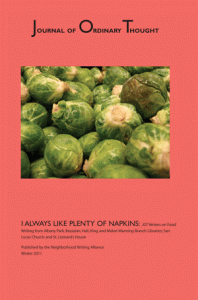 The Neighborhood Writing Alliance publication Journal of Ordinary Thought focuses its Winter 2011 on food: “I Always Like Plenty of Napkins.” From the introduction: “There is very little about food that remains unexplored in this delectable volume of reflections, prose, and poetry. And because food arguably stimulates our sensorium like nothing else possibly can, these texts give powerful expression to the entire range of our sentient existence.”
The Neighborhood Writing Alliance publication Journal of Ordinary Thought focuses its Winter 2011 on food: “I Always Like Plenty of Napkins.” From the introduction: “There is very little about food that remains unexplored in this delectable volume of reflections, prose, and poetry. And because food arguably stimulates our sensorium like nothing else possibly can, these texts give powerful expression to the entire range of our sentient existence.”
Read the full introduction at JOT as well as two sample poems, “By the Roaring Fire” by Allen McNair and “MORE THAN SOUP” by Hector Vasquez.
Whiskey
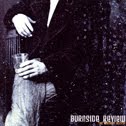 Burnside Review: The Whiskey Edition
Burnside Review: The Whiskey Edition
Need I say more?
Good Art Bad Art: Is There A Difference?
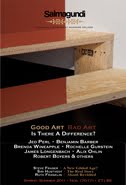 The Spring-Summer issue of Salmagundi boldly takes on the question of “Good Art Bad Art: Is There A Difference?” in the following symposium:
The Spring-Summer issue of Salmagundi boldly takes on the question of “Good Art Bad Art: Is There A Difference?” in the following symposium:
“Vagrant Thought About Quality” by Jed Perl
“Aesthetic Values” by Rochelle Gurstein
“Patriotism, Autonomy and Subversion” by Benjamin Barber
“On Emily Dickinson” by Brenda Wineapple
“The Attack on Beauty” by Robert Boyers
“Art and Values: What is Possible” by Charles Molesworth
“Why is a Good Poem Good?” by James Longenbach
“On Bad Writing” by Alix Ohlin
“Words in Search of a Masterpiece” by Mitchell Cohen
What if…
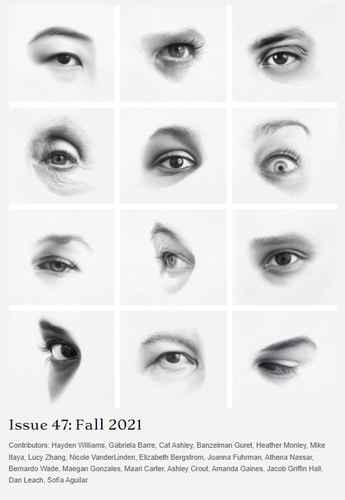 New Orleans Review (v31n2) opens with this quote from James Whitehead in New Orleans Review, volume 1 number 4, summer 1969:
New Orleans Review (v31n2) opens with this quote from James Whitehead in New Orleans Review, volume 1 number 4, summer 1969:
“What if the planet is being ruined by smoke and gas and oil? What if we’re killing the whales and eagles: killing even our natural symbols? What if shortly, by way of waste or the bombs, we don’t have us a good ole planet around any more? Where do we stage our tragedy and comedy then?”
Habitus: The Berlin Issue
 Issue No. 7 of Habitus, a publication “rooted in the experience and language of the Jewish diaspora,” focuses on Berlin. In his editorial, “Becoming Berlin,” Joshua Ellison explores the role of memory in the Berlin culture and society. He writes, “For societies, memory becomes a matter of public accountability, so the moral stakes are high. The painful process—very much active and agonizing in Germany—of defining and interpreting shared history is part of the pact we enter that creates community. In public, we decide what to remember, and that tells us something essential about who we are now. Berlin is so dense with reminders of the past that the contemporary city sometimes seems to recede, driven under the surface by their weight. But the question of what Berlin’s memorial culture tells us about contemporary Germany is still an open one.”
Issue No. 7 of Habitus, a publication “rooted in the experience and language of the Jewish diaspora,” focuses on Berlin. In his editorial, “Becoming Berlin,” Joshua Ellison explores the role of memory in the Berlin culture and society. He writes, “For societies, memory becomes a matter of public accountability, so the moral stakes are high. The painful process—very much active and agonizing in Germany—of defining and interpreting shared history is part of the pact we enter that creates community. In public, we decide what to remember, and that tells us something essential about who we are now. Berlin is so dense with reminders of the past that the contemporary city sometimes seems to recede, driven under the surface by their weight. But the question of what Berlin’s memorial culture tells us about contemporary Germany is still an open one.”
The full editorial is available online.
Open Minds :: Women & Mental Illness
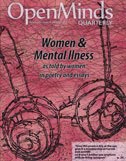 Open Minds Quarterly remains one of my favorite stalwart publications. I first used it when I taught a writing course themed “Understanding Disability,” and have remained a fan ever since. It is published by the Northern Initiative for Social Action out of Sudbury, Ontario, with the tag line: “Your psychosocial literary journal.” Never afraid to take on mental health issues most ‘in the news’ but certainly least understood (like PTSD when so many vets began – and yes continue – returning home to inadequate health care and support), this latest issue is yet another example of the importance of the publication’s role for readers and writers. The winter 2011 issue is focused on “Women & Mental Illness: As told by women in poetry and essays.” The publication remains fearless in its position that “consumers/survivors of mental health services are intelligent, creative, and can make a valuable contribution to society if given the opportunity to do so.” It behooves each of us to finish out this contribution by reading what these brave and talented authors have to share.
Open Minds Quarterly remains one of my favorite stalwart publications. I first used it when I taught a writing course themed “Understanding Disability,” and have remained a fan ever since. It is published by the Northern Initiative for Social Action out of Sudbury, Ontario, with the tag line: “Your psychosocial literary journal.” Never afraid to take on mental health issues most ‘in the news’ but certainly least understood (like PTSD when so many vets began – and yes continue – returning home to inadequate health care and support), this latest issue is yet another example of the importance of the publication’s role for readers and writers. The winter 2011 issue is focused on “Women & Mental Illness: As told by women in poetry and essays.” The publication remains fearless in its position that “consumers/survivors of mental health services are intelligent, creative, and can make a valuable contribution to society if given the opportunity to do so.” It behooves each of us to finish out this contribution by reading what these brave and talented authors have to share.
What’s in The Cupboard?
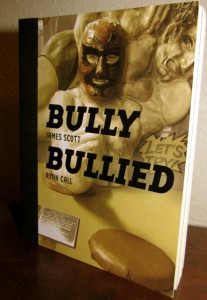 Co-edited by emily danforth, Dave Madden, and Adam Peterson and published in Lincoln, Nebraska, The Cupboard was originally a monthly ‘pamphlet,’ and downloads of the first sixteen issues can be found in the archives on the website. These can be printed and “assembled” by readers from PDFs.
Co-edited by emily danforth, Dave Madden, and Adam Peterson and published in Lincoln, Nebraska, The Cupboard was originally a monthly ‘pamphlet,’ and downloads of the first sixteen issues can be found in the archives on the website. These can be printed and “assembled” by readers from PDFs.
The Cupboard has evolved into a quarterly publication of creative prose with each volume featuring a body of work by a single author. Design and layout are done by William Todd Seabrook.
Recent authors include James Scott / Ryan Call, Andrew Borgstrom, Amanda Goldblatt, Joshua Cohen, Michael Stewart, Caia Hagel, Mathias Svalina, Louis Streitmatter, and Jesse Ball.
The Cupboard is also holding its first-ever contest, featuring guest judge Michael Martone. The winning author will receive $500 and publication. Manuscripts between 4,000 and 10,000 words, of one piece or many, are being accepted until March 31, with the contest fee applied to a subscription if the writer chooses.
Pudding Magazine New Editor
Connie Everett has taken over the editorial role for Pudding Magazine, one of the longest-running print journals in the U.S. Printed by Pudding House Press, Pudding Magazine continues its quarterly tradition with a look to updating guidelines, subscriptions, and submissions online. Welcome aboard Connie – great to see PM continue onward and e-ward!
Happy 50th Another Chicago Magazine
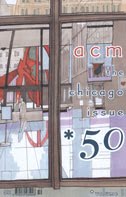 ACM – Another Chicago Magazine celebrates its 50 issue with this year’s first volume.
ACM – Another Chicago Magazine celebrates its 50 issue with this year’s first volume.
“To be perfectly honest,” the Statement of Purpose in 50.1 reads, “we never thought we’d make it to a 50th issue. ACM has never been known for fundraising skills, financial acumen, or an airtight organizational structure. Mostly we’ve just been known for being independent since 1977 and for publishing young and exciting writers as frequently as we can manage it on a shoestring budget.”
And to celebrate these roots and publishing, this issue is indeed “Another Chicago Issue” (split into two issues this year) featuring Chicago writers from “wildly different backgrounds and styles: novelists, experimental poets, writers with agents and book deals, writers who’ve only just begun to place work, editors, publishers, and general roustabouts and hermits alike.”
How can we resist?
New Madrid on Water
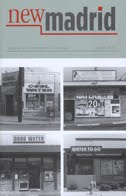 Editor Ann Neelon writes in her introduction to The New Madrid that the Winter 2011 issue “commemorates the declaration by the General Assembly of the United Nations in July 2010 that access to safe and clean drinking water and sanitation is a basic human right. It also solemnizes the terrifying fury of the floods that have ravaged the planet this year in Kentucky and Tennessee, as well as in Pakistan, Poland, Portugal, Brazil, China, France, Romania, Ukraine, Hungary, Peru, Mexico, Canada, Columbia, Australia, Indonesia, Serbia, Argentina, Kenya, Nigeria, Spain, Guatemala, and Singapore. We’ve all gotten used to images of streets turned into rivers, people with no belongings any more being transported in boats instead of cars. Water, water everywhere, but not a drop for anguished refugees to drink.”
Editor Ann Neelon writes in her introduction to The New Madrid that the Winter 2011 issue “commemorates the declaration by the General Assembly of the United Nations in July 2010 that access to safe and clean drinking water and sanitation is a basic human right. It also solemnizes the terrifying fury of the floods that have ravaged the planet this year in Kentucky and Tennessee, as well as in Pakistan, Poland, Portugal, Brazil, China, France, Romania, Ukraine, Hungary, Peru, Mexico, Canada, Columbia, Australia, Indonesia, Serbia, Argentina, Kenya, Nigeria, Spain, Guatemala, and Singapore. We’ve all gotten used to images of streets turned into rivers, people with no belongings any more being transported in boats instead of cars. Water, water everywhere, but not a drop for anguished refugees to drink.”
Contributers to this issue include Mario Chard, Teresa Milbrodt, Ruth Goring, Jennifer Atkinson, Scott Gould, Karen Holmberg, Matthew Nienow, Jeff Fearnside, Kristian Ansand Walter, Anthony Opal, Nikki Zielinski, Peter F. Murphy, Randall Horton, Ellen Ann Fentress, Deborah Bauer, and Sant Khalsa (photographer/cover art).
Hunger Mountain Bradbury Lists
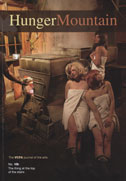 For Hunger Mountain #15, Editor Michiah Bay Gault offered a challenge to several writers as well as contributors included in the issue. Write a “Bradbury List” – writing practice of word association which Bradbury shares in his Zen and the Art of Writing. Contributors include Bruce Smith, Michael Martone, Angie Estes, Paul Lisicky, Ted Sanders, Jededian Berry, Weston Cutter, Richard Adams Carey, Casey Thayer, David Yost, Deborah Vlock, Gladys Haunton, Stacy Heiney, Jaydn DeWald, J.D. Lewis, Josie Sigler, Lee Wind, Mark Halliday, Melissa Febos, Michael Burkard, and Mojie Crigler. None of these list contributions were “edited or polished,” and so represent a wide variety of free association samples by writers. Fun stuff!
For Hunger Mountain #15, Editor Michiah Bay Gault offered a challenge to several writers as well as contributors included in the issue. Write a “Bradbury List” – writing practice of word association which Bradbury shares in his Zen and the Art of Writing. Contributors include Bruce Smith, Michael Martone, Angie Estes, Paul Lisicky, Ted Sanders, Jededian Berry, Weston Cutter, Richard Adams Carey, Casey Thayer, David Yost, Deborah Vlock, Gladys Haunton, Stacy Heiney, Jaydn DeWald, J.D. Lewis, Josie Sigler, Lee Wind, Mark Halliday, Melissa Febos, Michael Burkard, and Mojie Crigler. None of these list contributions were “edited or polished,” and so represent a wide variety of free association samples by writers. Fun stuff!
Spoon River Poetry River Digs Deeper into the Critical Essay
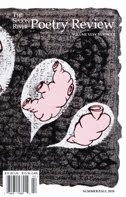 Kristin Hotellina Zona, the new editor of Spoon River Poetry Review, introduces herself in the Summer/Fall 2010 issue by making promises to both maintain traditions and make some changes. One change will be more prose in the magazine, since both readers and writers “depend upon criticism that engages the poem directly.” Thus, SRPR “will now feature a substantial analytical essay that blurs the line between the relatively short, opinion-driven review and conventional criticism.” The issue features Andrew Osborn’s review, “Like Animals, Like Love,” which includes readings of new books by Peter Campion, David Baker, and Melissa Range in the “model of critical investment” Zona hopes to see regularly with each issue.
Kristin Hotellina Zona, the new editor of Spoon River Poetry Review, introduces herself in the Summer/Fall 2010 issue by making promises to both maintain traditions and make some changes. One change will be more prose in the magazine, since both readers and writers “depend upon criticism that engages the poem directly.” Thus, SRPR “will now feature a substantial analytical essay that blurs the line between the relatively short, opinion-driven review and conventional criticism.” The issue features Andrew Osborn’s review, “Like Animals, Like Love,” which includes readings of new books by Peter Campion, David Baker, and Melissa Range in the “model of critical investment” Zona hopes to see regularly with each issue.
Happy 50th American Short Fiction
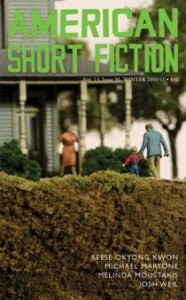 Launched in 1991, American Short Fiction celebrates its 50th issue with Winter 2010. Congrats ASF!
Launched in 1991, American Short Fiction celebrates its 50th issue with Winter 2010. Congrats ASF!
Tipton Poetry: Local Global Lit Mag
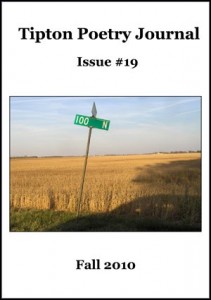 Tipton Poetry Journal is one of those great, saddle-stitched journals that looks local, but packs a helluva global content. The Fall 2010 issue includes a kasen renga, a form of Japanese collaborative poetry consisting of a chain of 36 verses. “Kasen Renga: Autumn” is a collaboration between Joyce Brinkman, Kae Morii, and Carolyn Kreiter-Foronda. Also featured is Rohana McCormack’s “First Snow” – an English translation of Sergey Yesenin’s original Russian poem, “Я по первому снегу бредуand,” and Liang Yujing’s “Four Pseudo Haiku” written in English and self-translated into Chinese.
Tipton Poetry Journal is one of those great, saddle-stitched journals that looks local, but packs a helluva global content. The Fall 2010 issue includes a kasen renga, a form of Japanese collaborative poetry consisting of a chain of 36 verses. “Kasen Renga: Autumn” is a collaboration between Joyce Brinkman, Kae Morii, and Carolyn Kreiter-Foronda. Also featured is Rohana McCormack’s “First Snow” – an English translation of Sergey Yesenin’s original Russian poem, “Я по первому снегу бредуand,” and Liang Yujing’s “Four Pseudo Haiku” written in English and self-translated into Chinese.
WLT Explores Science and Literature
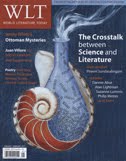 The January 2011 issue of World Literature Today, guest edited and introduced by Pireeni Sundaralingam, includes a symposium on The Crosstalk between Science and Literature:
The January 2011 issue of World Literature Today, guest edited and introduced by Pireeni Sundaralingam, includes a symposium on The Crosstalk between Science and Literature:
Physicist Alan Lightman and philosopher Rebecca Newberger Goldstein discuss how they devise “emotional experiments” in their fiction in order to probe the limits of rational thought. [Full text online]
In a provocative essay, poet and cognitive scientist Pireeni Sundaralingam asks, Are science and poetry inherently at odds with each other? [Full text online]
Authors Suzanne Lummis, Philip Metres, Vincenzo Della Mea, and Tone Hødnebø conduct playful experiments in new poems tied to the issue’s theme.
Berlin-based architect Eric Ellingsen co-opts the repeating structure of the poetic villanelle to remap space and to explore how literature might inform urban design.
Welsh poet-physician Dannie Abse traces the intersections of poetry and medicine in his own life and work.
Playwright Kenneth Lin discusses theater’s ability to convey the grandeur of scientific discovery. [Full text online]
The Florida Review Native Issue
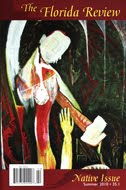 The newest issue of The Florida Review (35.1) is a special issue – the first “special issue” published by the Review – “Native Issue.” Dedicated to memory of the award-winning novelist and critic Louis Owens. Editor Toni Jensen comments on the theme: “The writers whose work is featured in this issue come from any different places – tribal, geographic, aesthetic. These differences are to be celebrated, embraced, because they help eradicate the idea that there is one Native literature or one idea of what it means to be Native.”
The newest issue of The Florida Review (35.1) is a special issue – the first “special issue” published by the Review – “Native Issue.” Dedicated to memory of the award-winning novelist and critic Louis Owens. Editor Toni Jensen comments on the theme: “The writers whose work is featured in this issue come from any different places – tribal, geographic, aesthetic. These differences are to be celebrated, embraced, because they help eradicate the idea that there is one Native literature or one idea of what it means to be Native.”
A full table of contents for this issue is available on The Florida Review website.
PEN America Looks at Lovers
 PEN America #13 is themed “Lovers” and features a forum on literary love with contributions from Jessica Hagedorn, John Barth, Yusef Komunyakaa, Stewart O’Nan, Anne Landsman, Sa
PEN America #13 is themed “Lovers” and features a forum on literary love with contributions from Jessica Hagedorn, John Barth, Yusef Komunyakaa, Stewart O’Nan, Anne Landsman, Sa
Singleton and Weales Featured
 The Winter 2010 issue of The Georgia Review offers two special features: one on George Singleton and one on Gerald Weales.
The Winter 2010 issue of The Georgia Review offers two special features: one on George Singleton and one on Gerald Weales.
The Singleton feature includes two stories, “Vaccination” and “Jayne Mansfield,” which, Editor Stephen Corey notes brings the total number of Singleton stories published by TGR to 11 – putting him “at the head of the quantity class for our fiction writers.” But, more importantly, Corey notes, these two selections “show one of America’s best seriocomic authors at the height of his varied strengths.” Also included in the Singleton feature is “A Holy Impropriety: the Stories of George Singleton” by William Giraldi.
The Weales feature includes “Being Out Front at American Theater: An Interview with Gerald Weales” by Stephen Corey and “American Theater Watch, 1977-2010” – excerpts from decades of Weales annual feature. Corey introduces these selections he made from over 400 pages of Weales’s contributions to the magazine.
